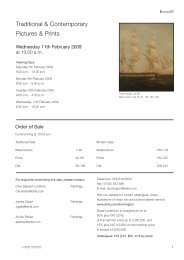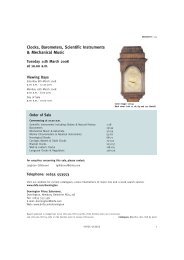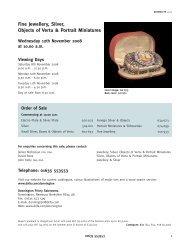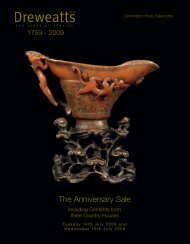Donnington Priory Salerooms
Donnington Priory Salerooms
Donnington Priory Salerooms
You also want an ePaper? Increase the reach of your titles
YUMPU automatically turns print PDFs into web optimized ePapers that Google loves.
50<br />
97<br />
97<br />
A rare Queen Anne ebonised thirty-hour longcase clock<br />
Robert Rouch, Bristol, early 18th century<br />
The posted countwheel bell-striking movement with anchor<br />
escapement and 11 inch square brass dial with herringbone border<br />
engraved calendar aperture incorporating pinhole adjustment and<br />
rectangular silvered signature plaque Rich’d Rouch, Bristol to the<br />
matted centre, within an applied silvered Roman numeral chapter ring<br />
with Arabic five minutes and stylised fleur-de-lys half hour markers,<br />
with original pierced steel hands and gilt female mask and scroll cast<br />
spandrels to angles, the case with silvered wood ball finials and<br />
domed caddy to the blind fret fronted box upstand, above moulded<br />
cornice with conforming fret to frieze and integral columns to hood<br />
door, the trunk with concave throat moulding and lenticle-centred<br />
rectangular door, on plinth base with moulded skirt, 220cm high.<br />
Provenance: the property of a private collector.<br />
Robert Rouch is recorded in Bellchambers, J.K. Somerset<br />
Clockmakers as working in Bristol circa 1725-55, where he is listed<br />
as ‘a fine maker’. A single-handed clock by Dennis Chambers of<br />
Pucklechurch with identical engraved half-hour markers is illustrated<br />
in Darken, Jeff and Hooper, John English 30 Hour Clocks Origin &<br />
Development 1600-1800 on page 145. The calendar has the<br />
unusual feature of pin-hole adjustment for advancing the date at<br />
the end of shorter months, a feature normally associated with the<br />
workshop of Thomas Tompion and his successor George Graham.<br />
The case is a rare survivor and is in good original condition<br />
considering its pine construction, and was made by a cabinet<br />
maker who successfully captured the feel and proportions of a<br />
high-end London case of the period.<br />
£1,500-2,000<br />
98<br />
A mahogany eight-day longcase clock<br />
Francis Rowbotham, Hampstead, 18th century<br />
The four-pillar rack and bell striking movement with calendar<br />
aperture and subsidiary seconds dial to the matted centre within an<br />
applied silvered Roman numeral chapter ring with fleur-de-lys half<br />
hour markers, Arabic five minutes and signed Francis Rowbotham,<br />
HAMPSTEAD to lower edge, the angles with twin cherub and crown<br />
pattern spandrels beneath STRIKE/SILENT dial flanked by dolphin<br />
mounts to arch, now in a case with dentil cornice to the break-arch<br />
pediment above fluted pilasters to hood, break-arch trunk door and<br />
plinth base with moulded skirt 205cm high.<br />
£900-1,100<br />
99<br />
A George III mahogany eight-day longcase clock<br />
William Peterson, London, late 18th century<br />
The five-pillar rack and bell striking movement with 12 inch single<br />
sheet brass break-arch Roman numeral dial with subsidiary<br />
seconds and calendar dials and signed W’m Peterson, London to<br />
centre within chapter ring with Arabic five minute outer track, and<br />
foliate spray engraved lower spandrels, the arch with<br />
STRIKE/SILENT dial flanked by festoon decoration continuing down<br />
to the upper spandrels, the case with reduced pagoda pediment<br />
above break-arch trunk door flanked by brass stop-fluted quarter<br />
columns, on shaped raised panel fronted plinth base with shallow<br />
moulded skirt (generally distressed) 211cm high.<br />
£1,000-1,500<br />
www.dnfa.com/donnington






